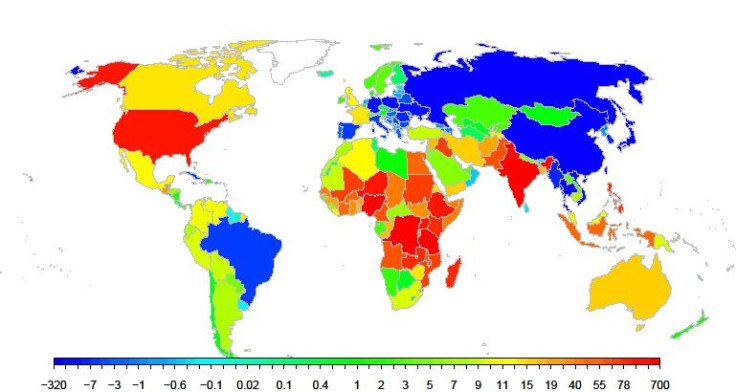UN Projection: Global Population Will Boom to 9.6 Billion By 2050; Nigeria to Surpass US

A new United Nations statistical projection shows the global population, currently 7.2 billion, barreling past 8.1 billion by 2025, to 9.6 billion people by the year 2050, and then almost 11 billion by 2100.
For context, the world's population passed 6 billion in 1999, and only reached 7 billion in 2011.
The new assessment is almost 800 million people higher than the previous global population estimate of 10.1 billion, which was calculated in 2011.
The projected growth will be led largely by booming fertility in Africa, where the current population of about 1.1 billion may quadruple to almost 4.2 billion by the end of the century.
"Although population growth has slowed for the world as a whole, this report reminds us that some developing countries, especially in Africa, are still growing rapidly," said the United Nations Under-Secretary-General for Economic and Social Affairs, Wu Hongbo, in a press release.
John Wilmoth of the UN's Department of Economic and Social Affairs acknowledged in a UN press conference that the new figures are only estimates, though projections based on current fertility and longevity rates are generally a reliable indicator of future population growth.
Projecting Population Growth
The report, called World Population Prospects: the 2012 Revision, uses computational methods developed by statistics and sociology professor Adrian Raftery and his colleagues at the University of Washington.
Previous UN calculations provided high and low future population projections based on the assumption that women will have about half a child more or less than the most specific projection. That method projects an enormous range by the year 2100, from 7 billion to 17 billion.
The UW group's fine-tuned methods, however, led to much more specific intervals, from 9 billion to 13 billion by the end of the century.
The researchers' refined statistical techniques allowed them to anticipate life expectancy and fertility trends based on updated UN demographic data from 2010, leading to a surprising conclusion about Africa in particular.
"The fertility decline in Africa has slowed down or stalled to a larger extent than we previously predicted, and as a result the African population will go up," said Raftery in a UW news release.
Global Population Highs and Lows: India, China, and Nigeria on Top
According to a helpful population graphic from the Guardian, India will surpass China as the world's most populous nation by 2028, when both countries average 1.45 billion people. After that point, India will keep growing to around 1.55 billion by 2100, while China's population will shrink to about 1.09 billion.
Meanwhile, Nigeria will leave the United States, currently the world's third most populous nation, in the dust by 2050. While the United States is expected to grow from 316 million today to around 462 million by 2100, Nigeria will boom from a mere 163 million two years ago to 914 million by the end of the century.
While the populations of currently developed nations are likely to remain stable at about 1.3 billion until 2050, or decline slightly, the 49 least developed countries are expected to double in size from about 900 million today to 1.8 billion in 2050.
Fertility rates are quickly dropping among current highly populous nations like China, India, Indonesia, Iran, Brazil, and South Africa.
Europe is expected to shrink by 14 percent over the next century as its population rapidly ages and declines in fertility.
Low fertility nations include all those in Europe except Iceland, notes USA Today, as well as 19 nations in Asia, 17 in North and South America, two in Africa, and one in the Pacific. Eastern European nations like Russia, Ukraine, Belarus, Bulgaria, Georgia, Latvia, Lithuania, Moldova, Romania, Serbia, and Croatia will be hit especially hard in the coming decades, with declines of over 15 percent.
However, global growth will continue to be driven by highly fertile African countries like Nigeria, Niger, Ethiopia, and Uganda, as well as others like Afghanistan and Timor-Leste, which all average over five children per woman.
Dealing with the Population Boom
"These figures are a wake-up call for all countries, including developing countries with young populations," said Silvia Stefanoni, interim head of HelpAge International, to the Guardian.
Among the pressing problems of young people in those nations will be a massive contraction of available employment in the event of a continuously sluggish global economy.
Discounting fears of a Malthusian population collapse, Raftery said that there is no foreseeable end to the global population increase. Since pressing problems like climate change and global hunger are both strongly linked to population growth, he said that it is imperative for world leaders to address the boom in developing nations.
"These new findings show that we need to renew policies, such as increasing access to family planning and expanding education for girls, to address rapid population growth in Africa," said Raftery.
Sources:
World Population Prospects: the 2012 Revision. United Nations Department of Economic and Social Affairs, Population Division. 2013.
Scruton, P. Major populations in 2100. The Guardian. 2013.
Published by Medicaldaily.com



























